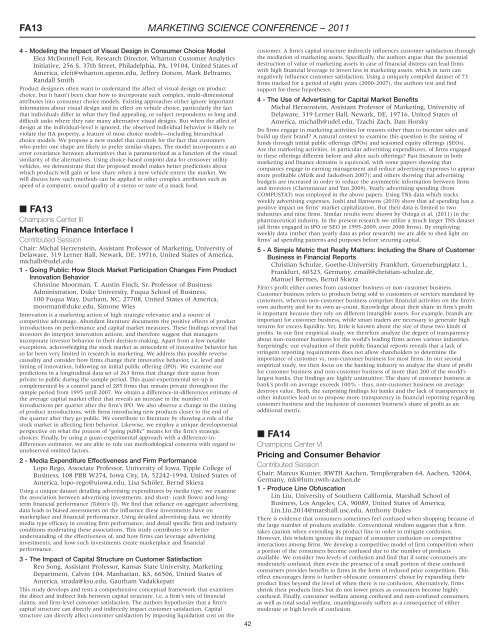Conference Sessions - Jesse H. Jones Graduate School of ...
Conference Sessions - Jesse H. Jones Graduate School of ...
Conference Sessions - Jesse H. Jones Graduate School of ...
You also want an ePaper? Increase the reach of your titles
YUMPU automatically turns print PDFs into web optimized ePapers that Google loves.
FA13<br />
4 - Modeling the Impact <strong>of</strong> Visual Design in Consumer Choice Model<br />
Elea McDonnell Feit, Research Director, Wharton Customer Analytics<br />
Initiative, 256 S. 37th Street, Philadelphia, PA, 19104, United States <strong>of</strong><br />
America, efeit@wharton.upenn.edu, Jeffrey Dotson, Mark Beltramo,<br />
Randall Smith<br />
Product designers <strong>of</strong>ten want to understand the affect <strong>of</strong> visual design on product<br />
choice, but it hasn’t been clear how to incorporate such complex, multi-dimensional<br />
attributes into consumer choice models. Existing approaches either ignore important<br />
information about visual design and its effect on vehicle choice, particularly the fact<br />
that individuals differ in what they find appealing, or subject respondents to long and<br />
difficult tasks where they rate many alternative visual designs. But when the affect <strong>of</strong><br />
design at the individual-level is ignored, the observed individual behavior is likely to<br />
violate the IIA property, a feature <strong>of</strong> most choice models—including hierarchical<br />
choice models. We propose a new model that controls for the fact that customers<br />
who prefer one shape are likely to prefer similar-shapes. The model incorporates a an<br />
error covariance between alternatives that is parameterized as a function <strong>of</strong> the visual<br />
similarity <strong>of</strong> the alternatives. Using choice-based conjoint data for crossover utility<br />
vehicles, we demonstrate that the proposed model makes better predictions about<br />
which products will gain or lose share when a new vehicle enters the market. We<br />
will discuss how such methods can be applied to other complex attributes such as<br />
speed <strong>of</strong> a computer, sound quality <strong>of</strong> a stereo or taste <strong>of</strong> a snack food.<br />
■ FA13<br />
Champions Center III<br />
Marketing Finance Interface I<br />
Contributed Session<br />
Chair: Michal Herzenstein, Assistant Pr<strong>of</strong>essor <strong>of</strong> Marketing, University <strong>of</strong><br />
Delaware, 319 Lerner Hall, Newark, DE, 19716, United States <strong>of</strong> America,<br />
michalh@udel.edu<br />
1 - Going Public: How Stock Market Participation Changes Firm Product<br />
Innovation Behavior<br />
Christine Moorman, T. Austin Finch, Sr. Pr<strong>of</strong>essor <strong>of</strong> Business<br />
Administration, Duke University, Fuqua <strong>School</strong> <strong>of</strong> Business,<br />
100 Fuqua Way, Durham, NC, 27708, United States <strong>of</strong> America,<br />
moorman@duke.edu, Simone Wies<br />
Innovation is a marketing action <strong>of</strong> high strategic relevance and a source <strong>of</strong><br />
competitive advantage. Abundant literature documents the positive effects <strong>of</strong> product<br />
introductions on performance and capital market measures. These findings reveal that<br />
investors do interpret innovation actions, and therefore suggest that managers<br />
incorporate investor behavior in their decision-making. Apart from a few notable<br />
exceptions, acknowledging the stock market as antecedent <strong>of</strong> innovative behavior has<br />
so far been very limited in research in marketing. We address this possible reverse<br />
causality and consider how firms change their innovative behavior, i.e. level and<br />
timing <strong>of</strong> innovation, following an initial public <strong>of</strong>fering (IPO). We examine our<br />
predictions in a longitudinal data set <strong>of</strong> 263 firms that change their status from<br />
private to public during the sample period. This quasi-experimental set-up is<br />
complemented by a control panel <strong>of</strong> 285 firms that remain private throughout the<br />
sample period from 1995 until 2007. We obtain a difference-in-differences estimate <strong>of</strong><br />
the average capital market effect that reveals an increase in the number <strong>of</strong><br />
introductions per quarter after the firm’s IPO. We also observe a change in the timing<br />
<strong>of</strong> product introductions, with firms introducing new products closer to the end <strong>of</strong><br />
the quarter after they go public. We contribute to literature by showing a role <strong>of</strong> the<br />
stock market in affecting firm behavior. Likewise, we employ a unique developmental<br />
perspective on what the process <strong>of</strong> “going public” means for the firm’s strategic<br />
choices. Finally, by using a quasi-experimental approach with a difference-indifferences<br />
estimator, we are able to rule out methodological concerns with regard to<br />
unobserved omitted factors.<br />
2 - Media Expenditure Effectiveness and Firm Performance<br />
Lopo Rego, Associate Pr<strong>of</strong>essor, University <strong>of</strong> Iowa, Tipple College <strong>of</strong><br />
Business, 108 PBB W274, Iowa City, IA, 52242-1994, United States <strong>of</strong><br />
America, lopo-rego@uiowa.edu, Lisa Schöler, Bernd Skiera<br />
Using a unique dataset detailing advertising expenditures by media type, we examine<br />
the association between advertising investments, and short- (cash flows) and longterm<br />
financial performance (Tobin’s Q). We find that reliance on aggregate advertising<br />
data leads to biased assessments on the influence these investments have on<br />
marketplace and financial performance. Using detailed advertising data, we identify<br />
media type efficacy in creating firm performance, and detail specific firm and industry<br />
conditions moderating these associations. This study contributes to a better<br />
understanding <strong>of</strong> the effectiveness <strong>of</strong>, and how firms can leverage advertising<br />
investments, and how such investments create marketplace and financial<br />
performance.<br />
3 - The Impact <strong>of</strong> Capital Structure on Customer Satisfaction<br />
Reo Song, Assistant Pr<strong>of</strong>essor, Kansas State University, Marketing<br />
Department, Calvin 104, Manhattan, KS, 66506, United States <strong>of</strong><br />
America, strada@ksu.edu, Gautham Vadakkepatt<br />
This study develops and tests a comprehensive conceptual framework that examines<br />
the direct and indirect link between capital structure, i.e. a firm’s mix <strong>of</strong> financial<br />
claims, and firm-level customer satisfaction. The authors hypothesize that a firm’s<br />
capital structure can directly and indirectly impact customer satisfaction. Capital<br />
structure can directly affect customer satisfaction by imposing liquidation cost on the<br />
MARKETING SCIENCE CONFERENCE – 2011<br />
42<br />
customer. A firm’s capital structure indirectly influences customer satisfaction through<br />
the mediation <strong>of</strong> marketing assets. Specifically, the authors argue that the potential<br />
destruction <strong>of</strong> value <strong>of</strong> marketing assets in case <strong>of</strong> financial distress can lead firms<br />
with high financial leverage to invest less in marketing assets, which in turn can<br />
negatively influence customer satisfaction. Using a uniquely compiled dataset <strong>of</strong> 73<br />
firms tracked for a period <strong>of</strong> eight years (2000-2007), the authors test and find<br />
support for these hypotheses.<br />
4 - The Use <strong>of</strong> Advertising for Capital Market Benefits<br />
Michal Herzenstein, Assistant Pr<strong>of</strong>essor <strong>of</strong> Marketing, University <strong>of</strong><br />
Delaware, 319 Lerner Hall, Newark, DE, 19716, United States <strong>of</strong><br />
America, michalh@udel.edu, Tzachi Zach, Dan Horsky<br />
Do firms engage in marketing activities for reasons other than to increase sales and<br />
build up their brand? A natural context to examine this question is the raising <strong>of</strong><br />
funds through initial public <strong>of</strong>ferings (IPOs) and seasoned equity <strong>of</strong>ferings (SEOs).<br />
Are the marketing activities, in particular advertising expenditures, <strong>of</strong> firms engaged<br />
in these <strong>of</strong>ferings different before and after such <strong>of</strong>ferings? Past literature in both<br />
marketing and finance domains is equivocal, with some papers showing that<br />
companies engage in earning management and reduce advertising expenses to appear<br />
more pr<strong>of</strong>itable (Mizik and Jackobson 2007); and others showing that advertising<br />
budgets are increased in order to reduce the asymmetric information between firms<br />
and investors (Chemmanur and Yan 2009). Yearly advertising spending (from<br />
COMPUSTAT) was employed in the above papers. Using TNS data which tracks<br />
weekly advertising expenses, Joshi and Hanssens (2010) show that ad spending has a<br />
positive impact on firms’ market capitalization. But their data is limited to two<br />
industries and nine firms. Similar results were shown by Osinga et al. (2011) in the<br />
pharmaceutical industry. In the present research we utilize a much larger TNS dataset<br />
(all firms engaged in IPO or SEO in 1995-2009, over 2000 firms). By employing<br />
weekly data (rather than yearly data as prior research) we are able to shed light on<br />
firms’ ad spending patterns and purposes before securing capital.<br />
5 - A Simple Metric that Really Matters: Including the Share <strong>of</strong> Customer<br />
Business in Financial Reports<br />
Christian Schulze, Goethe-University Frankfurt, Grueneburgplatz 1,<br />
Frankfurt, 60323, Germany, email@christian-schulze.de,<br />
Manuel Bermes, Bernd Skiera<br />
Firm’s pr<strong>of</strong>it either comes from customer business or non-customer business.<br />
Customer business refers to products being sold to customers or services mandated by<br />
customers, whereas non-customer business comprises financial activities on the firm’s<br />
own authority and for its own ac-count. Knowledge about their share in firm’s pr<strong>of</strong>it<br />
is important because they rely on different intangible assets. For example, brands are<br />
important for customer business, while smart traders are necessary to generate high<br />
returns for excess liquidity. Yet, little is known about the size <strong>of</strong> these two kinds <strong>of</strong><br />
pr<strong>of</strong>its. In our first empirical study, we therefore analyze the degree <strong>of</strong> transparency<br />
about non-customer business for the world’s leading firms across various industries.<br />
Surprisingly, our evaluation <strong>of</strong> their public financial reports reveals that a lack <strong>of</strong><br />
stringent reporting requirements does not allow shareholders to determine the<br />
importance <strong>of</strong> customer vs. non-customer business for most firms. In our second<br />
empirical study, we then focus on the banking industry to analyze the share <strong>of</strong> pr<strong>of</strong>it<br />
for customer business and non-customer business <strong>of</strong> more than 200 <strong>of</strong> the world’s<br />
largest banks. Our findings are highly unintuitive: The share <strong>of</strong> customer business at<br />
bank’s pr<strong>of</strong>it on average exceeds 100% - thus, non-customer business on average<br />
destroys value. Both, the surprising findings for banks and the lack <strong>of</strong> transparency in<br />
other industries lead us to propose more transparency in financial reporting regarding<br />
customer business and the inclusion <strong>of</strong> customer business’s share <strong>of</strong> pr<strong>of</strong>it as an<br />
additional metric.<br />
■ FA14<br />
Champions Center VI<br />
Pricing and Consumer Behavior<br />
Contributed Session<br />
Chair: Marcus Kunter, RWTH Aachen, Templergraben 64, Aachen, 52064,<br />
Germany, mk@lum.rwth-aachen.de<br />
1 - Produce Line Obfuscation<br />
Lin Liu, University <strong>of</strong> Southern California, Marshall <strong>School</strong> <strong>of</strong><br />
Business, Los Angeles, CA, 90089, United States <strong>of</strong> America,<br />
Lin.Liu.2014@marshall.usc.edu, Anthony Dukes<br />
There is evidence that consumers sometimes feel confused when shopping because <strong>of</strong><br />
the large number <strong>of</strong> products available. Conventional wisdom suggests that a firm<br />
takes caution when extending its product line in order to mitigate confusion.<br />
However, this wisdom ignores the impact <strong>of</strong> consumer confusion on competitive<br />
interactions among firms. We develop a competitive model <strong>of</strong> firm competition when<br />
a portion <strong>of</strong> the consumers become confused due to the number <strong>of</strong> products<br />
available. We consider two levels <strong>of</strong> confusion and find that if some consumers are<br />
moderately confused, then even the presence <strong>of</strong> a small portion <strong>of</strong> these confused<br />
consumers provides benefits to firms in the form <strong>of</strong> reduced price competition. This<br />
effect encourages firms to further obfuscate consumers’ choice by expanding their<br />
product lines beyond the level <strong>of</strong> when there is no confusion. Alternatively, firms<br />
shrink their products lines but do not lower prices as consumers become highly<br />
confused. Finally, consumer welfare among confused and non-confused consumers,<br />
as well as total social welfare, unambiguously suffers as a consequence <strong>of</strong> either<br />
moderate or high levels <strong>of</strong> confusion.

















